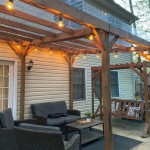How Much Does It Cost For A Brick Paver Patio?
The installation of a brick paver patio can significantly enhance a home's outdoor living space, providing an aesthetically pleasing and durable area for relaxation, entertainment, and al fresco dining. However, before embarking on such a project, it is crucial to understand the various cost factors involved. The overall expense of a brick paver patio isn't simply the price of the bricks themselves; it encompasses labor, materials, site preparation, and other considerations that can significantly impact the total investment. This article aims to provide a comprehensive overview of the elements influencing the cost of a brick paver patio, enabling homeowners to make informed decisions and budget effectively.
The cost of a brick paver patio is often calculated on a per-square-foot basis. National averages can range considerably, typically from $10 to $30 per square foot. This broad range reflects the diversity in project scopes, material choices, and regional labor rates. A small, simple patio using standard brick pavers in an area with competitive labor costs might fall closer to the lower end of the spectrum. Conversely, a larger, more complex patio employing high-end pavers, intricate designs, or located in a region with higher labor costs could easily reach the upper end of the range. Understanding these per-square-foot estimates provides a starting point for budgeting, but it is essential to delve deeper into the specific factors that contribute to the overall cost.
Key Cost Factor 1: Materials
The materials used in a brick paver patio project constitute a significant portion of the total cost. These materials extend beyond just the brick pavers themselves and include a variety of essential components necessary for a stable and long-lasting patio.
Brick Pavers: The type of brick paver selected is a primary determinant of material costs. Standard clay brick pavers are generally the most affordable option, offering a classic and timeless aesthetic. However, concrete pavers, which can be manufactured in a wide array of shapes, sizes, colors, and textures, offer greater design flexibility and can range from moderately priced to quite expensive depending on the complexity of the design and finish. Natural stone pavers, such as bluestone or flagstone, represent the premium end of the spectrum, offering a unique and luxurious look but coming with a corresponding price tag. Recycled pavers provide an environmentally-friendly option, often with unique aesthetics, but their availability and pricing can vary.
Base Materials: A properly prepared base is critical for the longevity of a brick paver patio. The base typically consists of several layers, starting with a compacted subgrade, followed by a layer of gravel and a layer of sand. The quality and quantity of these materials directly impact the patio's stability and resistance to settling or shifting over time. The cost of these base materials can vary depending on the local availability of gravel and sand, as well as the depth of the base required based on soil conditions and anticipated load.
Edging: Edging is used to contain the brick pavers and prevent them from shifting or spreading. Various edging options are available, ranging from plastic or metal edging to concrete curbing or even larger pavers set on their edge. The choice of edging material will impact both the aesthetic appeal and the cost of the project. More durable and visually appealing edging options, such as concrete curbing, will generally be more expensive than simpler solutions like plastic edging.
Joint Sand: Joint sand, typically polymeric sand, is used to fill the gaps between the brick pavers. Polymeric sand hardens when activated with water, creating a stable and weed-resistant surface. While seemingly a small detail, the cost of joint sand can add up, especially for larger patios. The type of joint sand used also influences the overall cost, with polymeric sand being more expensive than traditional sand.
Geotextile Fabric: Geotextile fabric is often used between the subgrade and the gravel base to prevent soil from mixing with the gravel, ensuring proper drainage and stability. This fabric is a relatively inexpensive material, but its use is crucial for the long-term performance of the patio.
Key Cost Factor 2: Labor
Labor costs represent a substantial portion of the overall expense of a brick paver patio. The complexity of the project, the skill level of the installers, and the geographic location all influence labor rates. It is prudent to obtain multiple quotes from reputable contractors to ensure competitive pricing and to assess the contractor's experience and qualifications.
Site Preparation: Site preparation involves clearing the area of existing vegetation, debris, and any existing structures such as old patios or walkways. It also includes grading the area to ensure proper drainage and compacting the subgrade to provide a stable foundation. This stage can be labor-intensive, especially if the site is uneven or requires extensive excavation. The necessity of significant excavation or demolition can substantially increase labor costs.
Base Installation: The installation of the base layers requires careful measurement, spreading, and compaction of the gravel and sand. This process often involves the use of machinery, such as a compactor, to ensure a solid and level foundation. Improper base installation can lead to settling and shifting of the pavers, so it is essential to hire experienced professionals who understand the importance of proper compaction.
Paver Installation: Laying the brick pavers themselves is a labor-intensive task, especially if the design is intricate or involves custom cuts. The pavers must be laid precisely to create a uniform and aesthetically pleasing surface. Skilled installers will also ensure proper spacing between the pavers for joint sand application.
Edging Installation: The installation of the edging requires careful placement and securing to prevent the pavers from shifting. This may involve digging trenches, setting the edging in concrete, or using other methods to ensure a stable and durable border.
Joint Sand Application and Compaction: Filling the joints between the pavers with sand and compacting the entire surface is the final step in the installation process. Polymeric sand requires careful application and activation with water to ensure proper hardening and weed prevention.
Clean-up and Disposal: After the patio is installed, the contractor will typically clean up the area and dispose of any excess materials or debris. This is a standard part of the labor cost, but it is important to clarify this with the contractor beforehand.
Key Cost Factor 3: Design Complexity and Site Accessibility
The design of the brick paver patio and the accessibility of the site can significantly impact the overall cost. Intricate designs require more labor and material waste, while difficult site access can increase labor time and equipment costs.
Design Complexity: A simple, rectangular patio with a straightforward paver pattern will be less expensive to install than a patio with curves, intricate patterns, or multiple levels. Custom cuts and intricate designs require more time and skill, increasing labor costs and potentially generating more material waste.
Patio Size: The size of the patio is a direct factor in material costs. A larger patio will require more pavers, base materials, and edging, thus increasing the overall expense. However, economies of scale can sometimes come into play, where the per-square-foot cost might decrease slightly for larger projects.
Site Accessibility: If the site is difficult to access, such as a backyard with limited access for machinery, the contractor may need to use manual labor to transport materials and equipment. This can significantly increase labor costs. Obstacles such as trees, fences, or utility lines can also complicate the installation process and add to the overall expense.
Existing Structures: The presence of existing structures that need to be removed or modified, such as old patios, walkways, or landscaping features, will add to the cost of the project. Demolition and removal of these structures can be labor-intensive and may require specialized equipment.
Permits: Depending on the location and the size of the patio, building permits may be required. The cost of these permits can vary depending on local regulations. It is essential to check with the local building department to determine if permits are needed and to factor the cost into the overall budget.
Additional Features: The inclusion of additional features, such as built-in seating, fire pits, outdoor kitchens, or lighting, will further increase the cost of the patio project. These features require additional materials, labor, and potentially specialized contractors.
Ultimately, determining the true cost of a brick paver patio requires careful consideration of all these factors. Obtaining detailed quotes from multiple contractors that clearly outline the scope of work, materials to be used, and labor costs is essential for accurate budgeting and informed decision-making. Homeowners should prioritize clear communication with contractors regarding design preferences, site conditions, and budget constraints to ensure the project meets expectations and stays within a reasonable financial framework.

How Much Does It Cost To Build A Paver Patio

How Much Does A Paver Patio Cost 2024 Data

How Much Does A Patio Cost Installation 2024 Landscaping Network

Cost To Install A Patio 2024 Calculator

How Much Does It Cost To Install Patio Pavers In 2024 Paver House

Paver Cost Landscaping Network

How Much Does A Paver Patio Cost 2024 Data
How Much Does A Paver Patio Cost Quora

So How Much Does A Paver Patio Actually Cost Hardscape Toledo

Guide How Much Does A Paver Patio Cost In 2024








